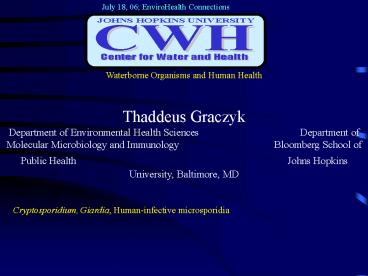Waterborne Organisms and Human Health - PowerPoint PPT Presentation
1 / 30
Title:
Waterborne Organisms and Human Health
Description:
Waterborne Organisms and Human Health – PowerPoint PPT presentation
Number of Views:42
Avg rating:3.0/5.0
Title: Waterborne Organisms and Human Health
1
July 18, 06 EnviroHealth Connections
Waterborne Organisms and Human Health
Thaddeus Graczyk
Department of Environmental
Health Sciences
Department of Molecular Microbiology and
Immunology
Bloomberg School of Public Health
Johns
Hopkins University, Baltimore, MD
Cryptosporidium, Giardia, Human-infective
microsporidia
2
(No Transcript)
3
May 26, 2000 / 49(SS04)1-35
4
(No Transcript)
5
- SIGNIFICANT CONTRIBUTION TO THE MORTALITY OF
IMMUNOSUPRESSED PEOPLE
- LACK OF EFFECTIVE PROPHYLACTIC OR THERAPEUTIC
MEDICATIONS
- ID50 FOR IMMUNOCOMPETENT PEOPLE 10-1000 OOCYSTS
IOWA 100 oocysts UCP 1,000 oocysts TAMU
10 oocysts MD 300 oocysts
- CALF DAILY, 109 OOCYSTS HUMAN DIARHOETIC FECES,
106 OOCYSTS/ML
- LONG LASTING INFECTIVITY IN THE ENVIRONMENT
6
1) Recovery of Oocysts from Water
Filtration, Continuous Flow Centrifugation,
Centrifugation
2) Detection of Oocysts in Recovered Substrate
Elution, Dissolution, Concentration,
Separation, Purification, Staining, Microscopic
examination, Flow cytometry
- Am Standards for Testing Materials Method (ASTM
Standards) - Standard Method (AWWA Standards)
- Alternate Method (Hansen Ongerth, 1991)
- Cellulose Acetate Membrane (CAM)-Filter
Dissolution Method (Graczyk et al., 1997) - Method 1622 (U.S. EPA) Method 1623 (U.S. EPA)
(limitations 10L, drinking water (low turbidity)
7
Cellulose Acetate Membrane (CAM)-Filter
Dissolution Method
2.5 - 39-cm-diameter 0.210.0 um pore
size
8
Graczyk et al. 1977. Recovery of waterborne
oocysts of Cryptosporidium from water samples by
the membrane filter dissolution method. Parasitol
Res 83 121-125.
Recovery Efficiency 78.7, CV 5.6
34.7
oocysts were not drained with the water
9
Host Specificity of Cryptosporidium
Cryptosporidium parvum (zoonotic humans)
C. hominis (humans)
C. muris (rodents)
C. andersoni (cattle)
C. felis (cats humans)
C. wrairi (guine
pigs)
C. canis (dogs
humans) C. meleagridis (birds-turkeys)
C. baileyi (birds) C. serpentis (snakes)
C. saurophilum (lizards) C.
nasorum (fish)
Molecular studies indicate that this genus is
complex and may contain many additional species
(Xiao, Ryan, Graczyk et al. 2004.
Appl Environ Microbiol 70 891-899)
10
1995 - 1998
Graczyk et al. 1995 Graczyk et al.
1996 Graczyk et al. 1998
Graczyk Cranfield 1998
11
Genotyping of Cryptosporidium PCR, RFLP
C. hominis
C. parvum
C. andersoni
SspI
C. muris
Sewage Wastewater discharges vs.
Agricultural runoff
VspI
12
Fluorescent In Situ Hybridization (FISH)
Giardia duodenalis
Cryptosporidium parvum
13
E. hellem
E. bieneusi
E. cuniculi
E. intestinalis
14
- PHASE I - Method selection
- PHASE II Wastewater effluent sampling
- PHASE III Sedimentation (3 WWTP)
- PHASE IV Water Plant influent sampling
- Base flow
- Storm event
- PHASE V Data evaluation/report prep. Etc.
Whats next?
- Sample Dataset
- Range 3 oocysts/liter - 570 oocysts/liter
- Average 171 oocysts/liter
- Median 20 oocysts/liter
- Highest concentrations found in samples collected
during plant failure
15
MCI-Antietam Sediment Sampling
No No No
Above
Stream Bank
98 132 67
Just Below
Farthest Downstream
10 8 14
- Samples from Hancock/Tolonoway showed similar
trend
16
17
Small watersheds
18
19
Foodborne Illnesses Vectored by Molluscan
Shellfish
- Pathogens associated with (raw) sewage disposal,
wastewater effluents, overboard disposal, and
runoff - Agents indigenous to coastal waters
- Post-harvest contamination
65
28
7
Graczyk Schwab 2000, Gastroenterol Rpts 2
305-309
20
Phagocytosis
96
Giardia duodenalis
2 hr
Cyclospora cayetanensis
14 days
Cryptosporidium parvum
21
1998-02 2002-06
22
Cryptosporidium
Fecal coliform
Dissolved O2
Oyster meat
Temperature
Salinity
23
- Monitoring of Water for Fecal Coliform Is not
Sufficient to Indicate the Presence of Human
Waterborne Pathogens - Oysters can cause cryptoptosporidiosis if
consumed raw - Oyster contamination coincides with rainfall
and stream flow into the Bay
Graczyk et al. 2002. Susceptibility of the
Chesapeake Bay to environmental contamination
with Cryptosporidium parvum. Environ Res 82
106-112.
Technological limitations mouse bioassay, PCR
24
- 2002-06
- 54 commercial bars only (30 oysters/bar)
- Oysters processed by six ( 1 meal)
25
Graczyk et al. Appl Environ Microbiol in press
Cumulative number of viable C. parvum oocysts
found in six oysters
Eastern Bay
Choptank River
Wye River
Upper Bay
Fluorescent In Situ Hybridization
Bars, 23 of 54 (42.3) Meals 130
of 324 (40.1)
26
Graczyk et al. Appl Environ Microbiol in press
Cumulative number of viable C. parvum oocysts
found in six oysters vs. water quality
parameters
Eastern Bay
Wye River
MPN/100 ml
27
Foodborne Outbreaks Vectored by Molluscan
Shellfish
Cases
Outbreaks
Graczyk Schwab 2000, Gastroenterol Rpts 2
305-309
28
73
WHO 2003 2.3 million children under 5 yr of age
die from diarrhea-related causes
29
(No Transcript)
30
(No Transcript)































